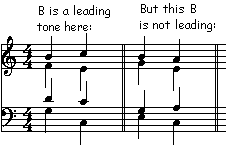Answer: Usually the term "leading tone" is applied to the 7th degree in a major scale or the raised 7th degree in a minor scale. For example, B in the key of C, or G# in the key of A minor. That is, this is the note that is just a half step away from the tonic and can seem to "lead" back to it (in minor keys the 7th degree is raised whenever it needs to function as a leading tone; the "natural" minor scale has no leading tone at all).
But here's the part that can lead the unwary astray: a note one half step below the tonic is not always serving as a leading tone. In the key of C, for example, you might have a melody that descends from C and passes through B on the way down, either as a dissonant "passing tone" or as part of an e minor harmony, in which cases it isn't really a leading tone. You can tell a real leading tone by its harmony, either real harmony or that implied by the melody. A leading tone would be part of a dominant chord (the V or V7 chord, or the vii dim. chord that is almost the same thing). But to use that B example again, if it was part of an e minor chord it wouldn't be a leading tone because the e minor harmony is not dominant; it's not trying hard to go anywhere in particular and if it does move it is more likely to move to the a minor chord rather than the tonic C major.

When the leading tone is part of a dominant harmony traditional counterpoint practice advises that it move to the tonic note as expected, particularly if it's in a part that's easy to hear, like the upper or lower voice. Otherwise it can seem a little disappointing.
To sum up, a leading tone is (1) a half-step away from its destination and (2) part of a harmony that is headed to that destination. Such a harmony is generally either the V chord or some other chord that is acting like a V (for example, D7 in the key of C, which is "V7 of V." In that chord the F# is the leading tone to the note G, as if you were changing now to the key of G).
In a more general sense, any note that is a half step from its destination and is part of a harmony that is tending to that destination could be called a leading tone, even including "upper leading tones" that lead downward by halfstep. But it's the rising leading tone that gets the most attention.

